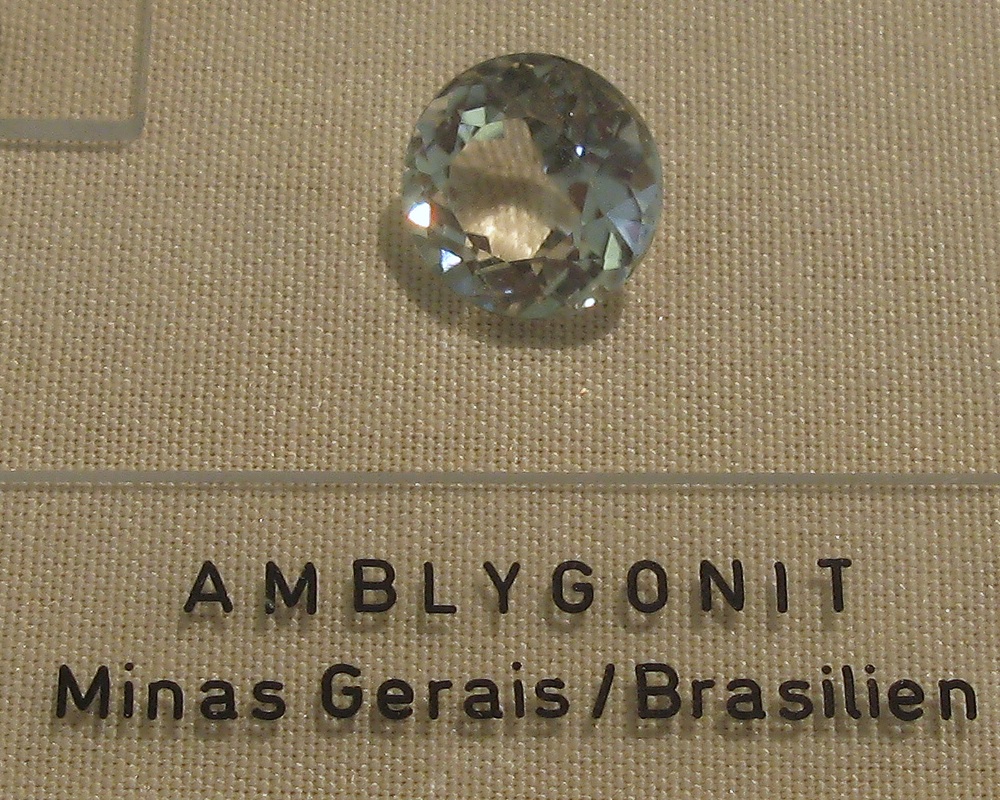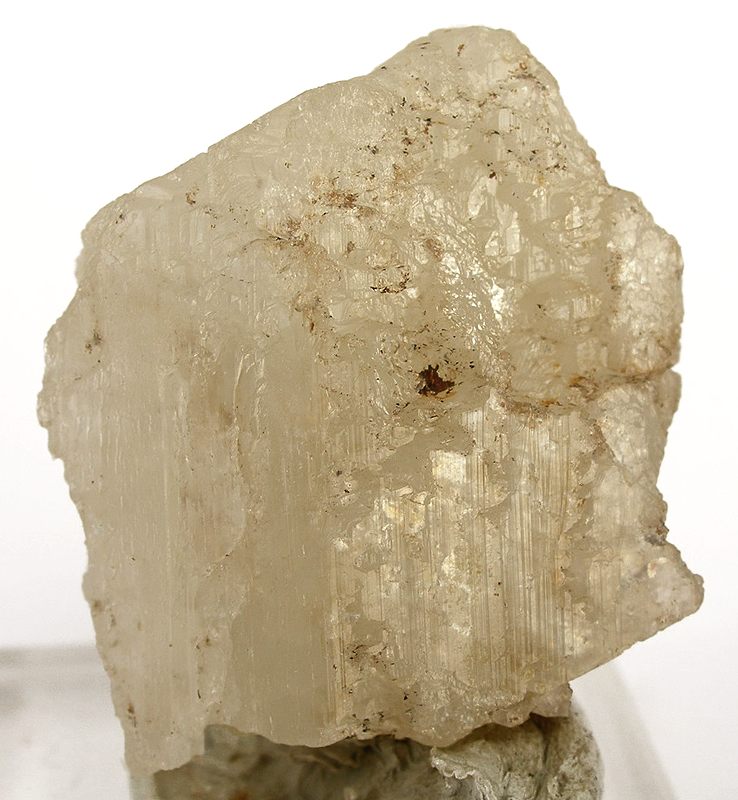
Amblygonite Gemstone: Properties, Meanings, Value & More
 Amblygonite is a lesser-known gemstone with a difficult name but gorgeous pastel colors. These gems are typically light yellow but also come in blues and greens.
Amblygonite is a lesser-known gemstone with a difficult name but gorgeous pastel colors. These gems are typically light yellow but also come in blues and greens.
Is amblygonite rare? As a mineral, no. But gem-quality amblygonite material is incredibly rare, especially in large sizes.
Join us as we uncover all of amblygonite’s properties, powers, prices, and history in this comprehensive guide!

What Are Amblygonite Gemstones?
Amblygonite is a rare semi-precious gemstone usually displaying white to light yellow colors, sometimes blue to green, and rarely pink to lilac.
Astrologically, amblygonite is lucky for Taurus.
Amblygonite vs spodumene is a common confusion — both are commonly yellow gems containing lithium and aluminum.
However, spodumene is more common. Plus, spodumene is a lithium aluminum silicate, while amblygonite is a lithium, aluminum, sodium, hydroxide fluorophosphate.
Amblygonite can also resemble petalite and beryl. Beryl is harder (7.5-8 on the Mohs scale) and petalite is monoclinic.
Industrially, what is amblygonite used for?
Amblygonite Uses
Like spodumene, amblygonite’s lithium content (about 10 percent of its composition) is its most important industrial property. According to the American Chemical Society, amblygonite joins spodumene and lepidolite as some of the few major lithium ores of economic importance.
Lithium sourced from amblygonite can be used to produce aluminum products, batteries, ceramic glazes, and glass, to name a few.
Amblygonite can also be used as a source of phosphorus. Additionally, amblygonite can increase glass opacity in products like dinnerware and porcelain enamels.
Scientists have made synthetic amblygonite but not for jewelry use.
 Pictured above: Montebrasite crystal with a coating of kosnarite | image credit: Rob Lavinsky, iRocks.com – CC-BY-SA-3.0
Pictured above: Montebrasite crystal with a coating of kosnarite | image credit: Rob Lavinsky, iRocks.com – CC-BY-SA-3.0
Amblygonite Specifications & Characteristics
As a lithium aluminum phosphate fluoride hydroxide, amblygonite’s chemical formula may be written as (Li,Na)AlPO4(F,OH) or LiAl(PO4)F. Low-sodium amblygonite stones may be called “hebronite.”
The stone belongs to the amblygonite group, which also includes montebrasite, natromontebrasite, and tavorite (not tsavorite). Amblygonite forms a series with montebrasite. (More on these other stones next!)
Amblygonite crystals are usually equant, prismatic and short, or columnar. Most crystals are crude; free-standing ones are rare. It can also be compact or massive.
Twinning is common in amblygonite, specifically microscopic polysynthetic twinning. Polysynthetic twinning is when multiple twinned crystals are aligned parallel.
You can distinguish amblygonite from stones like feldspars by its density, cleavage, and lithium reaction to a flame test (powdered amblygonite will produce a bright red flame).
Here are amblygonite’s properties listed:
Mohs hardness: 5.5-6
Color: White, grayish-white, cream, colorless, beige, light yellow, light green, light blue, bluish-green, brown; Rarely shades of pink to light purple
Crystal structure: Triclinic
Luster: Vitreous, sub-vitreous, resinous, greasy or pearly; Pearly on cleavages
Transparency: Transparent to translucent (gem); Translucent to opaque (industrial)
Refractive index: 1.577-1.633; Lowers with higher fluorine & sodium content
Density: 2.98-3.11
Cleavage: Perfect on {110}, Good on {110}, Distinct on {011}
Fracture: Irregular/uneven or subconchoidal
Streak: White
Luminescence: Fluorescence sometimes present, often patchy response - Green, orange, light brown, or yellowish-white in LW-UV & Light blue, orange, or yellowish-white in SW-UV; Light blue phosphorescence possible
Pleochroism: None
Birefringence: 0.019-0.027
Dispersion: 0.014 (weak)
 Pictured above: Montebrasite | Image credit: Rob Lavinsky, iRocks.com – CC-BY-SA-3.0
Pictured above: Montebrasite | Image credit: Rob Lavinsky, iRocks.com – CC-BY-SA-3.0
Types of Amblygonite Group Stones
The other members of the amblygonite group we’ll discuss are montebrasite and natromontebrasite.
Montebrasite
This stone is the most common member of the group, and many montebrasite specimens are mislabeled as amblygonite. Montebrasite is the hydroxyl-dominant end of the amblygonite-montebrasite series, with amblygonite as the fluorine-dominant end.
The colors of montebrasite include colorless, white, gray, light brown, light pink, and light yellow.
Montebrasite tends to have higher refractive indices and birefringence but lower density than amblygonite and natromontebrasite.
Speaking of which…
Natromontebrasite
As of 2006, natromontebrasite is technically not considered an official mineral species but a mixture of amblygonite, lacroixite, and wardite. Other terms for the stone include “natramblygonite” and “fremontite.”
The stone can be white, light yellow, pink, or light green.
Natromontebrasite usually has higher refractive indices but lower density than amblygonite.
Shifting from mineralogy, what is the spiritual meaning of amblygonite?
 Image credit: Ra'ike | CC-BY-SA-3.0
Image credit: Ra'ike | CC-BY-SA-3.0
Amblygonite Meaning & History
Amblygonite symbolizes warmth and passion, and it’s said to ignite your inner spark. It’s believed to broaden your perspective of the universe.
Additionally, amblygonite is sometimes nicknamed the “Prophet Stone.” Therefore, many believe amblygonite’s spiritual properties were used historically for facilitating communication with higher beings to receive guidance or insights about the future.
History
German mineralogist August Breithaupt discovered amblygonite in Saxony, Germany, but it was initially believed to be scapolite. Upon further analysis, Breithaupt realized that amblygonite’s cleavage angle was obtuse, not 90° like that of scapolite.
In 1817, Breithaupt published the discovery and named the stone from the Greek terms amvlys, meaning “blunt” and gonia, meaning “angle,” referencing the cleavage angle (or the stone’s common crystal habit, according to some sources).
French mineralogist Alfred Des Cloizeaux named montebrasite in 1871 (after several earlier, rejected attempts) after its type locality: the Montebras Mine in France.
Similarly, and shortly after, German mineralogist Franz Wolfgang Ritter von Kobell chose the name “hebronite” for a low-sodium amblygonite found in Hebron, Maine, USA in 1872.
Tavorite was discovered in Brazil in 1954. US Geological Survey (USGS) scientist Marie Louise Lindberg and USGS director William T. Pecora chose the name “tavorite” to honor Brazilian geologist Elysiário Távora.
 Image credit: Rob Lavinsky, iRocks.com – CC-BY-SA-3.0
Image credit: Rob Lavinsky, iRocks.com – CC-BY-SA-3.0
Amblygonite Healing Properties
As a primarily yellow healing stone, amblygonite joins other yellow gems in boosting confidence, intellect, and joy. They’re also great solar plexus chakra stones.
What is amblygonite good for physically?
Physical Healing
Physically, amblygonite is said to treat problems related to:
Electromagnetic radiation (EMF emissions)
Infections
ADHD
Fever
Thymus
Emotional Healing
Emotionally, amblygonite crystal benefits may include:
Mental clarity
Relaxation
Emotional stability
Problem-solving under pressure

Amblygonite Gemstone Properties
Amblygonite’s value depends on its color, cut, clarity, carat weight, and treatments. Color and carat weight are particularly important.
Color
Amblygonite is most often white to grayish-white. Other common colors are yellow, colorless, greenish-yellow, and green to blue shades. Pink to pale purple hues are rare and valuable.
Since most amblygonite gems are pale, darker hues are valuable.
Cut
Facetable amblygonite material is quite rare but makes gorgeous, valuable gems. Common faceted cuts include oval, trillion, and round shapes.
Lower-quality amblygonite (e.g. opaque, fractured, highly included) can become cabochons or carvings.
Clarity & Transparency
Clarity is the degree of visible inclusions in a gem, which can lower its transparency and value. Inclusions are fairly common in amblygonite.
Common types of inclusions include:
Veils
Hazy clouds in parallel bands along cleavage planes
Liquid inclusions creating a screen-like look
Higher transparency and fewer inclusions means higher value.
Carat Weight & Size
Most faceted amblygonite gems are 1-15 cts, though rarely over 10 carats. Uncut gem material is usually 10-15 cts, though the largest known amblygonite crystal weighed around 102 tons! The largest cut amblygonite weighs 70 carats.
Treatments
Light yellow amblygonite may be irradiated to become pale green. Treatments can lower value and should be disclosed by the seller.
 Image credit: Rob Lavinsky, iRocks.com – CC-BY-SA-3.0
Image credit: Rob Lavinsky, iRocks.com – CC-BY-SA-3.0
Amblygonite Formation & Sources
Amblygonite usually forms as a primary mineral, crystallizing from cooling magma as its parent rock solidifies. Typically, it forms in lithium- and phosphate-rich granite pegmatites. It’s also found in high-temperature tin veins and greisens.
However, many “amblygonite” specimens found in granite pegmatite crystal pockets are actually montebrasite.
Amblygonite can alter into smectite or kaolinite-mica mixtures. It can also alter into turquoise, morinite, lacroixite, wavellite, or wardite.
Mining Locations
The top sources for gem-quality amblygonite material are Brazil and the USA. South Dakota, USA, also produces huge masses of industrial-grade amblygonite.
Other significant gem-quality amblygonite sources are:
Germany
Sweden
Australia
France
Namibia
Norway
Spain
Myanmar
Namibia is known for rare purple amblygonites. Most gem-quality Brazilian specimens are yellow.
Gem-quality montebrasite sources are:
France
Namibia
Brazil
USA (Maine & New Hampshire)
Sources aside, how much is amblygonite worth?

Amblygonite Price & Value
Given their rarity, faceted amblygonite gemstones can be pricey. The biggest factors for faceted amblygonite value are color and carat weight.
Generally, the most valuable color for faceted amblygonite gems is pale green to bluish-green, costing around $100 to $160 per carat. Next is yellow-green faceted amblygonites, ranging from around $80 to $120 per carat.
Last are pale yellow faceted gems, ranging from about $50 to $80 per carat. Each of these has higher price-per-carat rates for larger sizes. You can find lower-priced faceted options with lower clarity (particularly yellow ones).
Faceted montebrasite gemstones are generally around $50 to $100 per carat.
Luckily, ornamental amblygonite stones are more affordable. Amblygonite cabochons can be roughly $1-$3 per carat. Rough crystals can be as low as $5 to $20.
Amblygonite Care and Maintenance
Amblygonite can be brittle and unstable, so proper gemstone care is crucial. When choosing jewelry, always opt for protective settings. We wouldn’t recommend amblygonite rings (even with protective settings) unless only worn occasionally.
Keep amblygonite away from:
High temperatures
Mechanical cleaning systems (e.g. steam, ultrasonic)
Harder gems
Acids (slowly dissolves)
The safest storage is in a display case away from harder gems.
 Image credit: Eurico Zimbres, CC-BY-SA-3.0
Image credit: Eurico Zimbres, CC-BY-SA-3.0
Create the Perfect Ambiance with Amblygonite!
Whether you wear it in a pendant or display it in your home, amblygonite emanates luxurious, calming vibes wherever it goes.
Search the Gemstone Encyclopedia
Related Auctions
Related Articles
Originally the Birthstones or gemstones were associated with a zodiac sign or the month of a individuals birth. Find out what your stone is and view the stones we have for sale
8th Feb 2021
There are dozens of quartz and chalcedony gems with various colors and patterns. Learn all about quartz properties and every type of quartz, from amethyst and agate to plasma and phantom quartz!
15th Oct 2020
Hackmanite is a pink to violet sodalite gem known for its unique color-change and luminescence. Learn why hackmanite is special, from its rare qualities to the types of hackmanite jewelry available.
28th Mar 2018
Latest Articles
Stibiotantalite is a rare tantalum mineral sometimes found as stunning yellow to orange gems. Discover the history, properties, prices, and uses of stibiotantalite gemstones in this complete guide.
21st Jan 2025
Milarite is a white, green, or yellow beryllium silicate in the milarite-osumilite group. Faceted gems are rare but stunning. Discover the history, properties, prices, and benefits of milarite gems!
6th Jan 2025
Friedelite is an uncommon pink, red, or brown manganese silicate mineral best known from New Jersey and South Africa. Learn the prices, properties, uses, and history of friedelite gemstones.
23rd Dec 2024
Article Categories
How To's is where you will find helpful articles from gem Rock Auctions on how to cut gemstones, select gemstones and buy gemstones.
9 Articles




